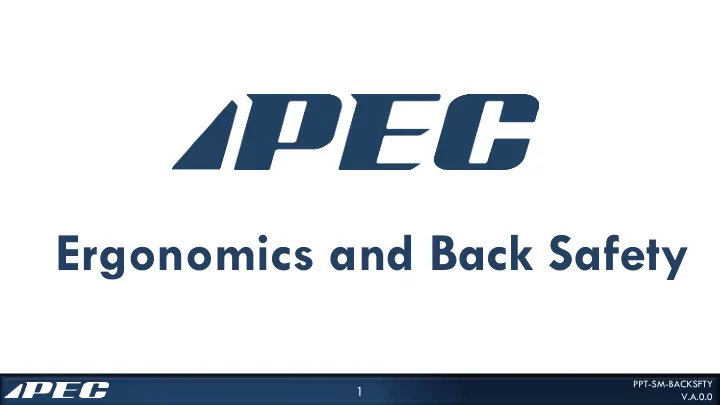

Ergonomics and Back Safety PPT-SM-BACKSFTY 1 V.A.0.0
Ergonomics and Back Safety Ergonomics • Scientific study of equipment design for the purpose of improving efficiency, comfort and safety PPT-SM-BACKSFTY 2 V.A.0.0
Ergonomics and Back Safety • Ergonomic risk factors – Repetitive, forceful or prolonged exertions of hands – Frequent or heavy lifting, pushing, pulling or carrying heavy objects – Prolonged awkward postures • Improper ergonomics can lead to musculoskeletal disorder (MSD) PPT-SM-BACKSFTY 3 V.A.0.0
Ergonomics and Back Safety To help prevent ergonomic injuries • Keep body in neutral position • Change working position throughout the day • Stretch fingers, hands, arms and torso • Periodically stand up and walk around PPT-SM-BACKSFTY 4 V.A.0.0
Ergonomics and Back Safety • Companies must perform hazard assessments to determine ergonomic controls • Immediate injuries to the back can be caused by tearing or straining ligaments • Minor, repeated damage over time can be as dangerous on your spine as one acute injury PPT-SM-BACKSFTY 5 V.A.0.0
Ergonomics and Back Safety • Back problems account for a large percentage of injuries to workers • Back injuries cause serious problems – Highest loss area in worker’s compensation claims – Leading cause of disability in workers – Health problems affecting quality of worker’s life PPT-SM-BACKSFTY 6 V.A.0.0
Common Causes of Back Injuries Usually the result of several combined risk factors Improper lifting Lifting items that are too heavy • Repetitive or forceful exertions is one of the • Stretching and lifting most common • Lifting and carrying a bulky load • causes of back Twisting at the waist and lifting • Bad posture problems. • Reaching above mid chest • Working or sitting for long periods • Slips, trips and falls • PPT-SM-BACKSFTY 7 V.A.0.0
Common Causes of Back Injuries Stress occurs when you • Bend at the waist • Lift a heavy object • Sit leaning forward • Have a spine degenerating disease PPT-SM-BACKSFTY 8 V.A.0.0
Common Causes of Back Injuries • Bending at the waist can add ten times the amount of force to the spine. • When you add in the 105 lbs. of the average upper torso, lifting a 10 lb. object actually puts 1,150 lbs. of pressure on your lower back. PPT-SM-BACKSFTY 9 V.A.0.0
Common Causes of Back Injuries • If you were 25 lbs. overweight, the extra weight increases your upper torso to 130 lbs. • That would add an additional 250 lbs. of pressure on your back, making it 1,400 lbs. of pressure every time you bend over PPT-SM-BACKSFTY 10 V.A.0.0
Symptoms • If back injury is suspected, immediately report the injury and have the injury examined • Signs and symptoms of back injuries – Pain – Numbness – Reduced range of motion – Stiffness – Weakness – Popping or grinding in the joints – Muscle spasms due to stress or tension PPT-SM-BACKSFTY 11 V.A.0.0
Identification of Job Hazards • It may be possible to redesign a job to make it less likely to cause injury • Companies should determine controls and procedures to reduce the number of back injuries • If you have suggestions, share information with supervisor PPT-SM-BACKSFTY 12 V.A.0.0
Prevention Engineering controls • Mechanical lifting aids • Adjustable worktables • Storing materials • Designing lighter materials PPT-SM-BACKSFTY 13 V.A.0.0
Prevention • Administrative controls – Training on ergonomic principles – Placing the right person for the job – Issuing changes • PPE – Not as effective at preventing back injuries as engineering controls PPT-SM-BACKSFTY 14 V.A.0.0
Prevention Reduce back injuries by Staying in good shape • Eliminating negative lifestyles by reducing stress and tension • Asking for help • Releasing stress to back by moving and stretching • Transferring weight for support • Practicing lumbar stabilization • Avoiding extreme force when using tools • Pushing rather than pulling loads • PPT-SM-BACKSFTY 15 V.A.0.0
Prevention • Proper lifting techniques – Position yourself close to the load – Spread feet a shoulder’s width apart – Keep knees bent, back straight – Tighten the stomach muscles – Lift using the large muscles of the legs – Avoid twisting your body • Keep object within safe lifting zone – Between waist and shoulders PPT-SM-BACKSFTY 16 V.A.0.0
PPT-SM-BACKSFTY 17 V.A.0.0
Recommend
More recommend